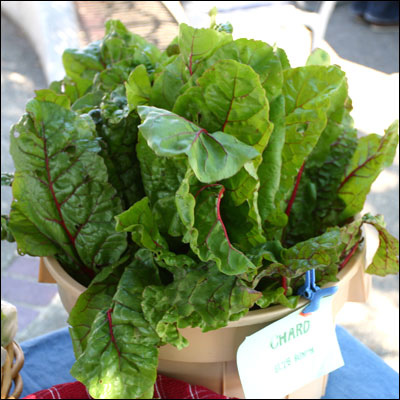
I have recently begun to more fully appreciate the charms of Swiss chard, particularly when it comes to green smoothies. Kale is arguably better for you, but Swiss chard blends up so much better. And by comparison to kale, Swiss chard is practically sweet.
Chard nutritional information
Also known as "silverbeet," chard is widely considered one of the healthiest vegetables around. It has been bred to have a ton of nutrition in the leaves, with very little in the root. (Unlike its cousin, beets, which have been selectively bred for the root.)

Image courtesy Flickr/Patent and the Pantry
Chard is high in vitamins A, C, and K, as well as a lot of different vitamins, minerals (including magnesium, which is hard to find elsewhere), and phytonutrients. Chard also has some interesting benefits when it comes to the pancreas and blood sugar levels, although more research in this area is necessary.
On the down side, chard also contains oxalic acid. If you are on an oxalate-free diet, or if you are concerned about oxalic acid, you will want to at least gently sautee chard for a few minutes before eating it. Even a quick blanching can greatly reduce the oxalic acid content.

Image courtesy Flickr/splorp
Choosing and storing chard
There are two basic types of chard you will find at the grocery store: regular Swiss chard and the red-stemmed or rainbow chard variety. Nutritionally these are both the same. From a cooking standpoint, the red stems are tougher and therefore not as easy to eat (many people strip off the green parts of the leaves and discard the red stems) whereas the white stems of the regular type of chard are more tender. However, red and rainbow chard are also more attractive, which can be fun, depending on your food presentation.
Chard should be stored in the fridge, as dry as possible. The leaves turn black and slimy quickly if they are stored wet. I often have to mop my chard with a paper towel before refrigerating it, thanks to the endless misting they receive in the grocery store produce section, chard tends to come home sopping wet.

Image courtesy Flickr/Patent and the Pantry
Preparing chard
The best way to prepare chard is to cut it into lots of thin ribbons. This is easy to do if you tear out the stems, then stack the leaves on your cutting board. Once you have a nice stack, simply slice them up as thinly as you want. You can also roll them up into a big tube and slice it that way, if you are having trouble hanging onto the stack of leaves.
If you decide to cook the stems, which are totally edible and a bit like celery, you will want to slice these up too. Because the stems are firmer than the leaves, it is often advisable to cook them separately from the green leaves. Put the stems in the pan first and give them a 5-10 minute head start before you add the leaves, depending on what you are cooking.

Image courtesy Flickr/M J M
Cooking with chard
Chard works great in the aforementioned green smoothies. Smoothies are also an excellent way to preserve the nutrients, since you don't lose anything to the heat of the cooking process, or lose any water-soluble nutrients into the boiling water. And it's not as bad as it looks! I make a smoothie with a banana, 2-3 chard leaves, and a generous amount of unsweetened vanilla almond milk.
The next best way to eat chard, from a nutritional standpoint, is to add it to soups. The cooking process will destroy some of the nutrients, but at least you are not losing anything to the boiling water.
Third down from a nutritional standpoint, but - to my mind - most delicious is to give chard a quick sautee on the stovetop. Pre-heat a skillet with a generous amount of olive oil and sautee the chard along with minced garlic, salt and pepper, and any other vegetables you want to toss in there. This makes a great, hearty, delicious side dish. The sautéed chard is quite tender.
You can also braise chard by basically doing the same thing but adding broth to the pan. This gives you a softer end result - too soft to my liking - but it also gives you a lot of great sauce, which makes this a good pairing for something like mashed potatoes where you can sop up the juice.
Main image courtesy Flickr/La Grande Farmers Market

0 comments